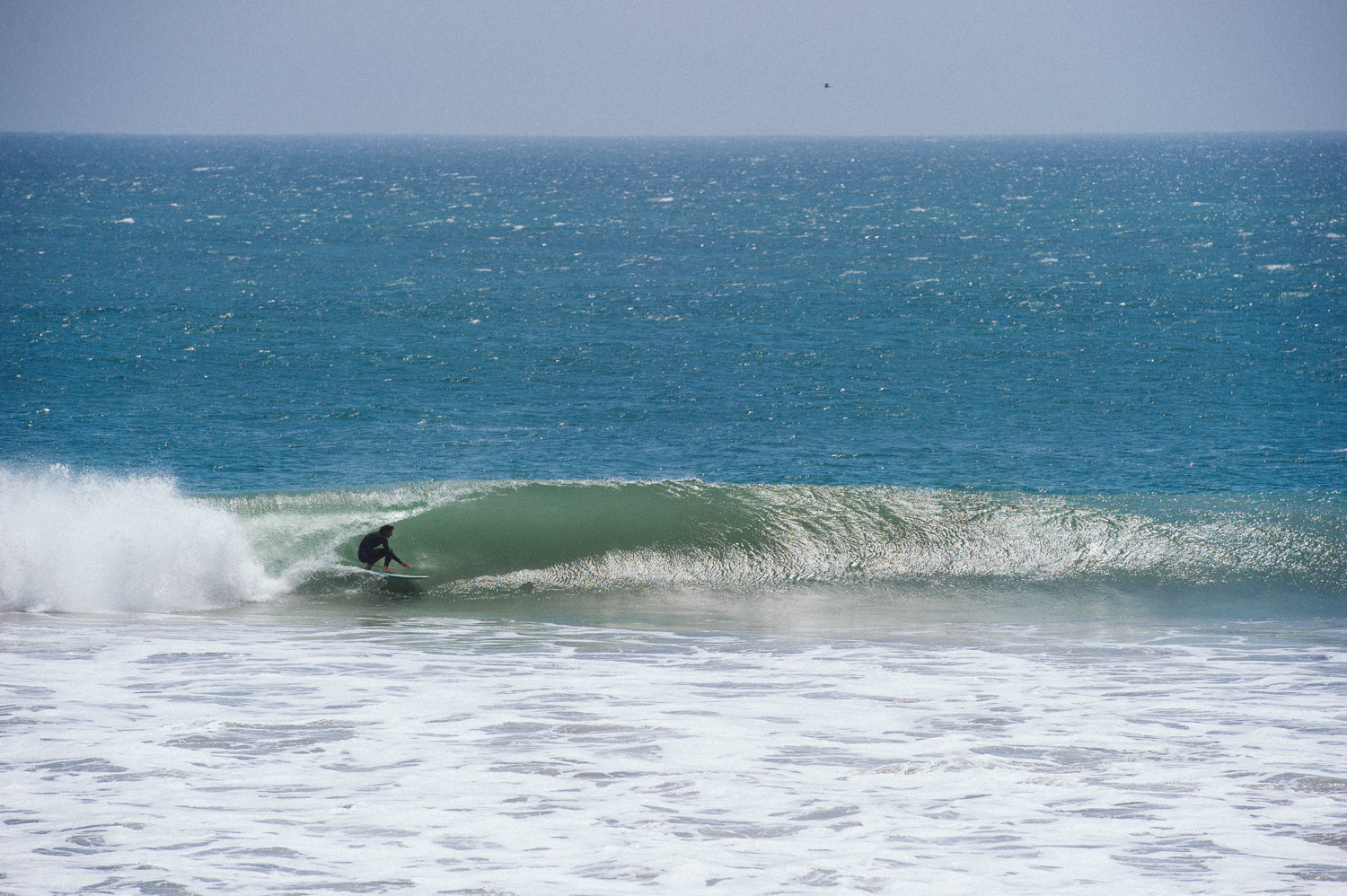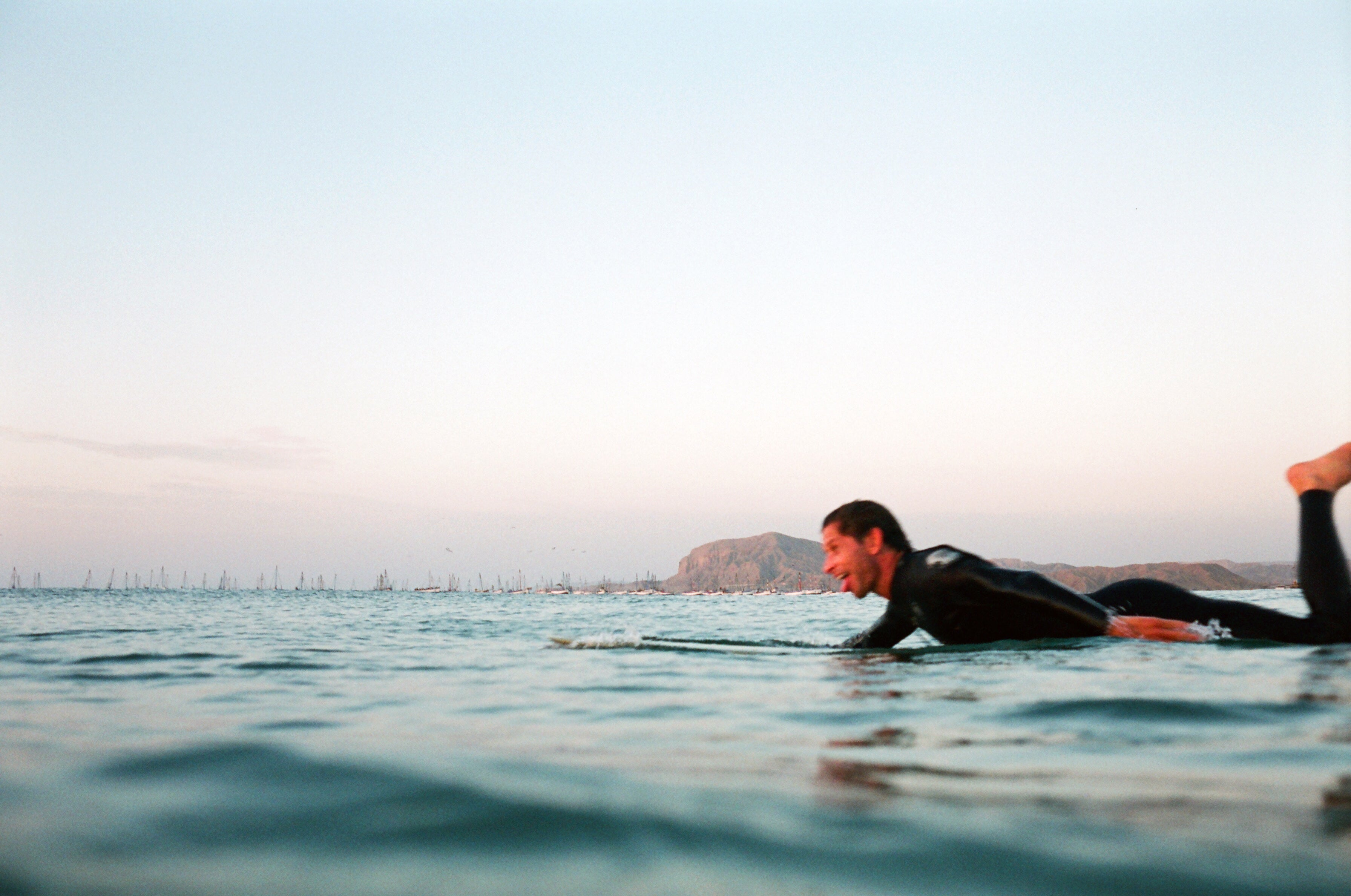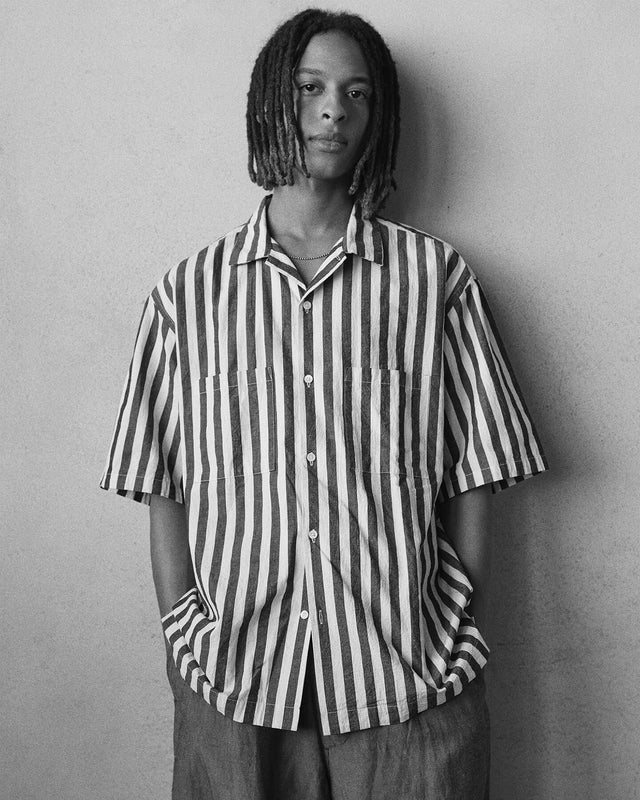A Testament To Joel Tudor And New York

[Joel Tudor sets up in Peru.]
‘Supernatural’ is the only word that applies to Joel Tudor and his grace on a surfboard. The side effects of him riding the nose have been illustrious in our contemporary surfing arena, setting Tudor apart from fellow surfers with superpowers. Since the late ’80s, his style, education, and influence have created a trickle down effect, dripping and seeping into what is today considered mainstream surf culture.
Tudor’s work is beyond simply bringing the past into the present, it’s more than a constant feeling of romance, reminiscing and nostalgia -- he ignited a desire to learn and experiment in the younger generation, diminishing the bi-partisanship between the longboard and the shortboard, creating an independent party of surfing elevation.
Here, we take a look back at Tudor’s connection to New York, his influential offerings to its surf culture and relevance, and paired it with previously unpublished photos from photographers Daniel Russo and Michael Halsband.



[Joel in Montauk, summer 2013.]
‘94 was the year Tudor made his way to New York by way of Tony Caramanico. He was 18. Over a cup of coffee in Montauk this past summer, Tudor told me how he’d met Caramanico in California, “I traveled a lot, and I remember Tony asked if I'd ever been to New York and I said no, and he was like, well, then you've never been anywhere.”
He remembers his first attempt at surfing Montauk, “Actually the first time I came to New York, Tony dragged us out in September but we got skunked. I came back the next year, in '95, and started to realize how much potential there was for the area.”
Michael Halsband, an esteemed portrait photographer and Tudor’s collaborator on Surf Book, first met Tudor at Ditch Plains, introduced by Caramanico. “I had always known of Joel from his interviews and being in surf movies, and I was a big fan, but also I thought he just spoke for the way I felt about surfing. I liked what he stood for.”
Halsband remembers what made Tudor stand out, “There was a lot of young attitude in the '80s. Then in the '90s, when Joel and a small group of people started bringing longboarding back into existence, they had to back it up. The way they did it was smart in the sense that they were extremely interested in the past and in tradition; like the WindanSea Surf Club, which Joel was a member of, and all the people he idolized because of what they contributed. It was this world of competitive longboard surfers, but also these people who were way under the radar, way off the grid, just living the life of being a surfer and were committed to it.”



[Joel surfing Peru.]
Mike Soloman, who has been surfing Long Island since the ‘60s, explains that part of what made Tudor so refreshing was how he was able to pick up on where surfing was headed as a culture, “What happened was that surfing itself got old enough to where there was a tradition that could be looked back on. Joel Tudor was young and went back to the beginning of our era and looked at it historically. Everybody else who had practiced longboarding were from that era. He wasn’t the only one, but one of the first, that had the genius to study that craft. He codified it in a sense. He was groomed by those older surfers, they saw it in him when he was really young. He was taken on these surf tours with Dora and Phil Edwards. Donald Takayama took him under his wing. They all saw that there was this person who could revivify something that was going to be lost. Through Joel, and then other young guys, surfing changed again, but it was because surfing was old enough.”
“When I first met Joel, the whole world was coming to him,” said Halsband. “He was so stoked and so excited. But he had something that was magical that inspired, or rather re-inspired, everybody from the past to look at something they had created. He was recognizing and paying respect to it. They had a chance to re-discover it and fall in love with it through him. I think that’s where he was unique, because there were other people his age at the same time really supporting the traditional longboard surfing style and method, as well.”

Tudor’s interest in surfing’s context came only second to his skill as a surfer, which is how he got people’s attention in New York’s waters. According to Soloman, “When Joel’s in the water, he’s like a seal. He’s not really like a human, he’s like some weird water creature. Joel started bringing in these shortboards and midlengths that were sort of returns back to the boards that I started off riding -- what we call midlengths now, which were the original shortboards, like 6’8” to 7’8”. People were watching what Joel was doing and then started riding those types of boards again. Ditch was a great wave for that, it’s a playful wave, an obstacle course type of wave where there’s lots of different things to do in different places. He really affected the area by coming here and surfing. That was really cool. People who were my age understood what he was doing, and understood how difficult it was, and he got a lot of respect.”






[Joel ripping Pipe.]
Soloman continues, “It was an epiphany for people to go wider, to think about flotation in a different way, and about a line in the wave that people had forgotten about. Joel was a revolutionary in both longboarding and in shortboarding because of what he did, and then what other people did after, changed shortboarding.”
Tudor believes surfers just needed a reminder, “It just took people time to realize how culture rich our stuff was, and how much cool shit they disregarded. In terms of trying to move forward with progression, they were forgetting our entire identity and the stuff that made us what we are as a group.”


Steve White, an artist, surfer, and New Yorker, also remembers meeting Tudor at Ditch Plains for the first time and seeing him surf, “The thing about Joel is that he has impeccable timing, he has a certain timing in the way he surfs, that’s just who he is, it’s not like he could speed it up or slow it down. He has real flow in the way his body moves on the board, or if he’s riding a shorter board, the way his body is moving in the tube. Whether you’re watching him in person or on film, you can see that he’s going for it.”
“Surfers think they are the only ones that know about waves or etiquette or shaping,” continues White. “Joel’s got very strong opinions, and he didn’t get there by not obsessing. He’s obsessive about everything he does. Whether I agree or disagree with him doesn’t really matter.”





[Peru gliding.]
Along with Tudor’s arrival on the east end also came more surfers, says Soloman, “There was a scene in Montauk of people who had been surfing since the ‘50s, who had come out basically from Gilgo Beach and those places and moved out here. I learned to surf at Georgica, it was a very underground thing for the longest of times. You would look for people to surf with for about 30 years, and then it’s changed now, now you look for an empty wave somewhere. Back then, it was really a wolfpack. Kind of sketchy surfing in the winter, back when wetsuits sucked and we didn’t have leashes. It was a little challenging. There were breaks that no one had ever ridden, just like anywhere else, and as time went on more and more people started surfing. The big thing didn’t really happen until the ‘90s, actually when Joel came out and Michael [Halsband] appeared.”



[Joel and the city.]
“Because of Tony [Caramanico]'s connection to art I got to hang out with Peter Beard and be around him when he was doing his diaries, rolling around on his property on acid as a kid,” Tudor recalls of his earliest experiences in Montauk. “And there was no one out here, it was a playground, it was a ghost town -- it was your very own little private escape. It was my own private world. No one knew how good the surf was, and I'd tell people and they wouldn't believe me. There was no Instagram to validate it, and no cameras that could take a picture to immediately send to your friends, it was all word of mouth. When I had come back to California and tell the guys they'd say 'Bullshit, the east coast sucks.' And I was like, ‘Alright it sucks.’”

[Joel surfs Ditch Plains.]
Tudor muses about New York surfers, “What's funny about here, I've never seen more people make excuses to try and find waves. I mean, they'll have perfect waves right in front of them and they'll be like, ‘Bro I'm going to this other place in 5 minutes, the Lighthouse is going to be amazing, let's meet at the Lighthouse and we all go to the Lighthouse.’ And then someone’s like, ‘I heard it's good back at Ditch,’ and they're all sitting there drinking coffee. It's almost kind of funny. They're always looking for a better wave when it's right there in front of them. That's the difference between California culture and here, if you’re in California and you get to the beach you just go because your time's running out, here they waste their time chasing the waves. It's almost like coffee talk, they like to have their coffee and talk about where they're gonna go. Not everybody, but the new generation of surfers out here are very comfortable holding a coffee cup.”

[Joel in the Ditch parking lot.]
Says Tudor of the massive spike of younger generation surfers in New York, “Social media has made it a huge thing for people to catch on to trends. But it's cool that it's becoming more available because it's educating more people, and the more that people are educated the more the ball gets moving. I dreamed that this shit would happen. The more that these kids are popping up, it discredits the mass-produced, completely heartless equipment.”
Soloman understands why, after seeing it firsthand, hoards of city folk would want their share of waves, “From the ‘90s on, it was articles in the New York Times and it’s just been waves of people coming and coming, and surfing, and getting more and more hungry. In a way it was really cool because it’s people coming from an urban environment, being romantic, trying to integrate with nature -- but you have to do it with respect or else you’ll get your ass handed to you.”





Bottom four sections of portraits of Joel Tudor courtesy of Michael Halsband, all other photos courtesy of Daniel Russo. Words by Chelsea Burcz.
